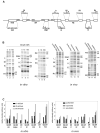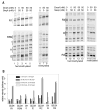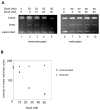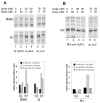SeqA blocking of DnaA-oriC interactions ensures staged assembly of the E. coli pre-RC
- PMID: 17114060
- PMCID: PMC1939805
- DOI: 10.1016/j.molcel.2006.09.016
SeqA blocking of DnaA-oriC interactions ensures staged assembly of the E. coli pre-RC
Abstract
DnaA occupies only the three highest-affinity binding sites in E. coli oriC throughout most of the cell cycle. Immediately prior to initiation of chromosome replication, DnaA interacts with additional recognition sites, resulting in localized DNA-strand separation. These two DnaA-oriC complexes formed during the cell cycle are functionally and temporally analogous to yeast ORC and pre-RC. After initiation, SeqA binds to hemimethylated oriC, sequestering oriC while levels of active DnaA are reduced, preventing reinitiation. In this paper, we investigate how resetting of oriC to the ORC-like complex is coordinated with SeqA-mediated sequestration. We report that oriC resets to ORC during sequestration. This was possible because SeqA blocked DnaA binding to hemimethylated oriC only at low-affinity recognition sites associated with GATC but did not interfere with occupation of higher-affinity sites. Thus, during the sequestration period, SeqA repressed pre-RC assembly while ensuring resetting of E. coli ORC.
Figures






References
-
- Bach T, Skarstad K. Re-replication from non-sequesterable origins generates three-nucleoid cells which divide asymmetrically. Mol Microbiol. 2004;51:1589–1600. - PubMed
-
- Baker TA, Bell SP. Polymerases and the replisome: machines within machines. Cell. 1998;92:295–305. - PubMed
-
- Bogan JA, Helmstetter CE. DNA sequestration and transcription in the oriC region of Escherichia coli. Mol Microbiol. 1997;26:889–896. - PubMed
Publication types
MeSH terms
Substances
Grants and funding
LinkOut - more resources
Full Text Sources
Molecular Biology Databases

